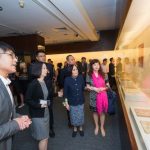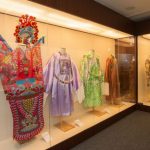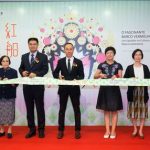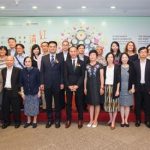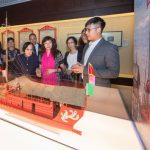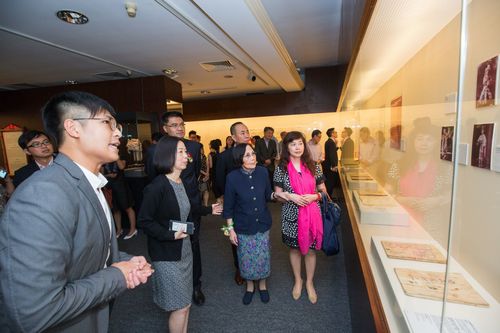 Temporary exhibition “The Enchanting Red Boat” was inaugurated showing the aesthetics of Cantonese Opera
Temporary exhibition “The Enchanting Red Boat” was inaugurated showing the aesthetics of Cantonese Opera
In order to promote the art of Cantonese Opera, the exhibition “The Enchanting Red Boat – An Episode of the Cantonese Opera Culture”, organised by the Macao Museum under the auspices of the Cultural Affairs Bureau, was inaugurated on Thursday, 26th May, at 6pm, in the lobby of the Macao Museum. The opening ceremony was officiated by the President of the Cultural Affairs Bureau, Ung Vai Meng; the Deputy Director of the Department of Education and Culture of the Liaison Office of the Central People's Government in the Macao S.A.R., Zhao Chuan Dong; the Deputy Director of Foshan Museum, Wang Haina; the President of the Macao General Association of Cantonese Opera, Lam Fong Ngo and the member of the Cultural Consultative Committee, Tong Mui Siu. As part of the programme of the 27th Macao Arts Festival, the exhibition is open to the public until 9th October. Cantonese Opera, also known as “Guangdong Drama”, is a distinctive local culture and art. Many repertoires were inherited from “zaju”, a variety show of the Yuan dynasty. Originating in Guangdong and Guangxi Provinces in the Ming and Qing dynasties, Cantonese Opera became popular in the Pearl River Delta and burgeoned in the late Qing dynasty. Cantonese Opera was inscribed on the Tentative List of the Macao SAR Intangible Cultural Heritage and on the National Intangible Cultural Heritage List in 2006, and it was also recognized by UNESCO and was officially inscribed on the Representative List of Intangible Cultural Heritage of Humanity in 2009, testifying to its artistic value and significance. In order to promote the art of Cantonese Opera and introduce its “beauty”, the Macao Museum organises the exhibition “The Enchanting Red Boat - An Episode of the Cantonese Opera Culture”. Its title, “Red Boat”, highlights the origin of Cantonese Opera. “Red Boat” refers to the boats painted in red in which the Cantonese Opera troupes were taken through the dense river network of Guangdong Province, as well as the costumes and sets of the performances. These troupes were known as “red boat troupes”. These red boats basically vanished due to the civil war occurred in the 1950s. The exhibition features nearly 100 artefacts, including the most representative artefacts of the Macao Museum related to Cantonese Opera, and other materials, photos and collections provided by Cantonese Opera associations and organizations. These artefacts include the costumes of renowned Cantonese Opera artist Chun Siu Lay, and traditional bamboo Chinese instruments made by Cantonese Opera musician Li Yui-cho, among others, illustrating the history, development and presentation of Cantonese Opera in Macao. Biographies of celebrated Cantonese Opera conductors will also be presented, allowing visitors to contemplate the beauty of this traditional art and the enchanting nostalgia it brings. The exhibition “The Enchanting Red Boat” features an educational area themed on Emperor Hua Guang, who is respected as a patron saint by Cantonese Opera artists, allowing visitors to have a better understanding of the customs of Cantonese Opera. In addition to the exhibition catalogue published by the Macao Museum as usual, three exquisite postcards specially designed by members of the Macao Animation & Comic Creators Association are available, adding the exhibition’s publications creative innovation. For more information on the exhibition and activities, please visit the Macao Museum website www.macaumuseum.gov.mo or call the Museum through tel. no. 2835 7911, during office hours.
View gallery

